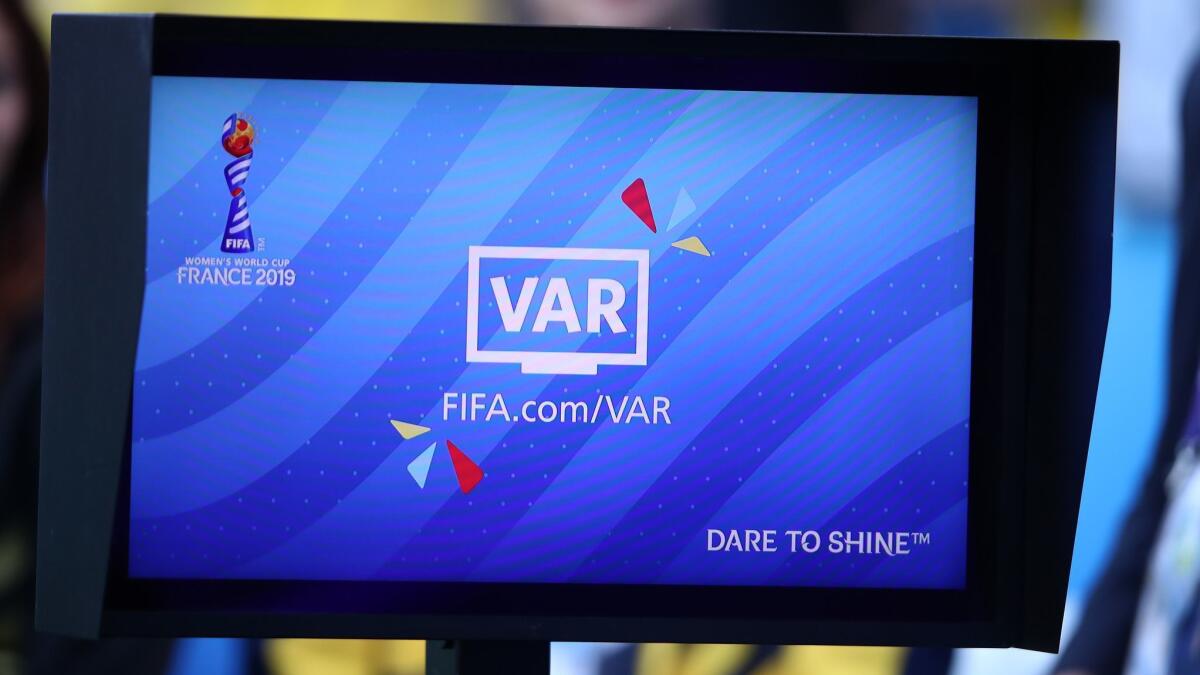For better or worse, VAR is making its presence known at the Women’s World Cup

- Share via
Reporting from REIMS, France — The video assistant referee, or VAR, is making its Women’s World Cup debut in France and it has played a huge role in the group stage, where 17 reviews were conducted, 16 of which resulted in a change to the call on the field.
Many of those changes were significant.
Australia, for example, rallied from a two-goal deficit to beat Brazil when an offside call against Sam Kerr was overturned following a review, helping the Aussies advance to the second round, while Scotland’s path through was blocked when VAR allowed Argentina a second shot at a penalty kick deep in stoppage time, resulting in a score and a draw.
Scottish keeper Lee Alexander appeared to secure her country’s first Women’s World Cup win and a spot in the knockout round when she made a dramatic stop of Florencia Bonsegundo’s penalty try. But the long lens of VAR showed she did not have part of her foot on the line as the ball was kicked and North Korean referee Ri Hyang-ok ordered the penalty retaken. This time Bonsegundo got the ball past a clearly rattled Alexander.
That was one of three penalty kicks ordered retaken after VAR found a goalkeeper infraction so slight that it probably would not have been called without the help of magnified, stop-action replay.
That’s not what the system was designed to do, said New Zealand coach Tom Sermanni.
“Can I be honest? Hopefully I can say this without any disrespect to anybody. I’ve been a bit disappointed in it,” said Sermanni, who has coached 14 Women’s World Cup games, tied for third most all time. “I think the idea is great. But I think sometimes the concept and idea, when it works out, as it comes out, is not always fantastic.
“It has taken an inordinate amount of time over decisions that are incredibly marginal. I think it’s made some very poor decisions.”
The International Football Association Board rule is clear: “The goalkeeper must have at least part of one foot on/in line with the goal line when the kick is taken; cannot stand behind the line.”
But forward movement is part of a goalkeeper’s technique for pushing themselves into a save position and it’s been tolerated for years. Forcing a keeper to remain flatfooted while the penalty taker is allowed to move is unfair, and as long as the violation isn’t egregious the rule has rarely been enforced.
VAR has changed that by giving officials the opportunity to go review, in detail, frame by frame, a goalkeeper’s movements before a penalty kick. Pierluigi Collina, chairman of FIFA’s refereeing committee, said the referees are getting it right.
“If a law exists, referees must enforce it — particularly when tools like VAR are available,” he said Friday. “For factual decisions, the number of centimeters doesn’t matter. If a ball is over the goal line by few centimeters, a goal must be still awarded. And if a foul is committed within the penalty area by few centimeters, a penalty kick must be given.
“It is the same for offside as there is not a ‘small’ or a ‘big’ offside — there is simply an offside. Today referees cannot justify a mistake by saying they couldn’t see because VAR [is] there to support their decision-making. Therefore if a goalkeeper commits an offense like encroaching before the penalty kick is taken, the VAR cannot do anything but intervene and inform the referee that the penalty kick must be retaken.”
Sign up for our weekly soccer newsletter »
U.S. coach Jill Ellis, whose team’s only meaningful brush with VAR proved advantageous when an apparent goal by Chile was disallowed, agreed with Collina.
“Why have a rule if you’re not going to enforce it?” said Ellis, who was among the early voices pushing for VAR to be included in the women’s tournament. “You can’t half-measure a rule. A rule is a rule.
“Overall, sitting here as a coach in the biggest tournament in the world, having the capacity to review situations, yeah, it’s a part of every other sport. There’s too much at stake to not have it in our sport.”
More to Read
Go beyond the scoreboard
Get the latest on L.A.'s teams in the daily Sports Report newsletter.
You may occasionally receive promotional content from the Los Angeles Times.







